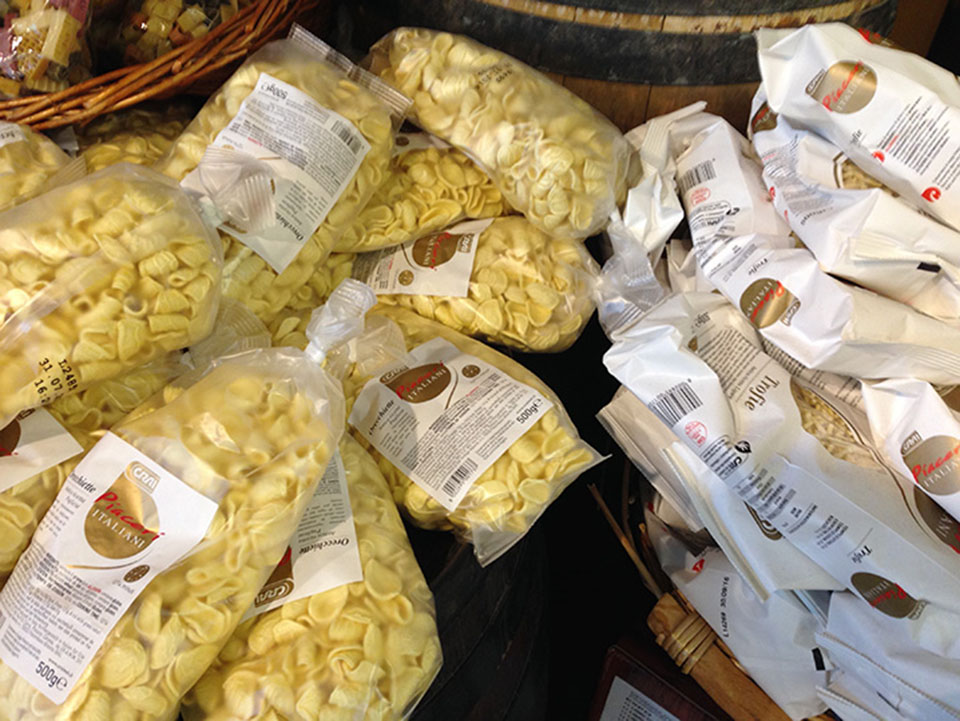
EU regulation 1169/2011: what changes for pasta manufacturers
13 February 2015 Off By PastariaEU regulation 1169/2011 came into effect on November 15, 2011, but only became fully applicable on December 13, 2014.
The new regulations represent a synthesis of over thirty years of discussion and EC measures involving food labeling. We return to this theme to discover what remains in effect from the pre-existing Italian measures contained in Leg. Dec. 109/1992 and examine the main innovations found in the EC regulations.
by Lino Vicini
Legislative Decree 109 of 1992 and EU Regulation 1169/2011
Legislative Decree no. 109 of 27 January 1992 has governed the labelling, presentation and advertising of foodstuffs in Italy for over twenty years.
These rules represent the implementation in our country of Community Directives on the subject of foodstuffs, issued in the course of the years (Directive 79/112/EEC and Directive 2000/13/EC to mention the most important).
Recently the European legislature issued EU Regulation 1169/2011 which provides a common text on the subject for all Member States of the European Union.
The aim pursued is to simplify the existing legislation, improve the regulations in force, and assign more responsibility to economic operators in connection with the information to be supplied on labels.
The aforementioned EU Regulation came into force on 15 November 2011 but has only been fully applicable since 13 December 2014.
This new legislation is the fruit of over four years of work by the European institutions and represents the synthesis of over thirty years of Community discussions and provisions on the subject of food labelling.
At the present moment the question posed by almost all food sector operators is the following: how much of the previous national legislation contained in Legislative Decree no. 109/1992 is actually still in force?
With a view to answering this question, it is important to specify how the succession of Italian and European laws actually works, given the fact that the mechanism that governs relations between internal and Community legislation is not common knowledge.
Repeal of the previous Community provisions on the subject of labelling and national rules
Art. 53 of Regulation 1169/2011 expressly repealed all previous Community directives on the subject of labelling, presentation and advertising of foodstuffs.
In this way, the Community legislature made a clean sweep of all the previous provisions issued over the course of time, replacing them with the measures laid down in the new Regulation.
The repeal of the old Community legislation is justified by a number of specific reasons.
In the first place, the European legislature attempted to harmonise and simplify the legislation by unifying in one consolidated act a multitude of provisions previously scattered in a variety of regulatory texts (labelling, presentation and advertising of foodstuffs, nutritional labelling, allergens).
Additionally, the choice, in contrast with the past, was to adopt standard rules for all of the countries of the European Union, through the approval of a single regulatory text.
As is widely known, the European regulation has a general and abstract nature equivalent to the legislation of the individual nations.
So the regulation has immediate effect in each individual member country and does not require internal implementing rules, as is the case with the directives.
Of course, the repeal of the Community provisions (directives) by the European legislature does not automatically annul the individual national implementing measures in the legal system of each member country.
As already mentioned, in fact, on the basis of the general principles, each individual State shall proceed to adapt its own legal system to the amendments made.
By way of example, this is exactly what happened a few years ago with the approval, by the Community legislature, of the provisions of the hygiene package in 2004 and the simultaneous repeal of all previous directives on the subject of foodstuffs with Directive 2004/41/EC.
First and foremost, the Community legislature, with this ultimate provision, dubbed by various reporters the “killer directive”, removed from the European legal system all the directives containing regulations on the hygiene of foodstuffs and the health provisions for the production and marketing of given products of animal origin intended for human consumption.
Subsequently, the Italian legislature intervened with an “ad hoc” regulatory provision in order to adapt the national legal system to the amendments passed.
So article 3 of Legislative Decree No. 193 of 6 November 2007 repealed as many as twenty-four Italian implementing measures of Community directives, which had become obsolete in the meantime due to the coming into force of the new Community regulations on the same subject.
In this way, moreover, the national Legislature proceeded to introduce penalties for the violation of the provisions contained in the above-mentioned Community regulations.
This double mechanism could repeat itself, also in connection with the legislation on the labelling of foodstuffs.
What’s new in the European legislation?
Let’s try now, through a brief overview of the new provisions, to verify whether there are any new elements to be added to labels for pasta manufacturers.
As a general rule, it may be said that the new regulation does not introduce any revolutionary measures in terms of the labelling, presentation and advertising of foodstuffs.
The standard legislation already introduced with the above-mentioned directives is essentially confirmed by the new rules.
There are certain welcome novelties connected with information on allergens and in general all the information supplied to consumers which is improved with a view to promoting a high level of protection of human health.
The rule followed by the Community legislature is that of establishing new obligations with regard to information on foodstuffs only where necessary, in compliance with the principles of subsidiarity, proportionality and sustainability.
The mandatory particulars to be displayed on the label are listed in Art. 4 of the Regulation.
This information may be essentially summarised in three sections: information on the identity and composition, properties or other characteristics of the foodstuff, information on the protection of the health of consumers and on the safe use of the product and, last but not least, information on nutritional properties which enable the consumer to make informed choices.
Mandatory particulars
The most important information for the consumer is clearly that relating to the contents and presentation of the foodstuff.
Let’s start with the minimum mandatory indications for food products.
With reference to the list of these indications, article 9 of the new Regulation demands that the following particulars be mentioned:
a) the name of the food;
b) the list of ingredients;
c) any allergens present;
d) the quantities of certain ingredients or categories of ingredients (QUID)
a) the net quantity of the food;
f) the date of minimum durability or the ‘use by’ date;
g) any special storage conditions and/or conditions of use;
h) the name or business name and address of the food business operator (responsible for the product);
i) the country of origin or place of provenance, where provided for;
j) the instructions for use where it would be difficult to make appropriate use of the food in the absence of such instructions;
k) for alcoholic drinks, the actual alcoholic strength by volume;
l) a nutrition declaration.
It is important to point out, with reference to the list of mandatory particulars, the superseding of the obligation originally laid down in article 3 paragraph 1 letter e) of Legislative Decree 109/1992.
It should not be forgotten that this provision required the indication on the label of the “name or business name or registered trademark and the address of either the manufacturer or packager or of a seller established within the EEC”.
But the regulation does not impose the obligation to indicate the site of production or packaging plant demanded by the Italian legislation since 1992.
This information can, therefore, be maintained on a purely voluntary basis by the party responsible for the product, and in any case provided that it is not supplied instead of the name or business name and address of the food business operator referred to in article 8 of the Regulation.
The name under which the product is sold (article 4 of Decree 109/1992) is superseded by the indication of the name of the food (art. 17 of the Regulation).
In the latter provision, this term refers to its legal name.
The innovative aspect consists of the fact that while the name under which the product is sold concerns the finished product, the name of the food regulates both the name of the finished product and the name of the ingredient.
The mandatory particulars on the foodstuffs provided for by art. 9 of Regulation 1169/2011 must, of necessity, be displayed on the label in words and figures.
The provision specifies that, without prejudice to the indications referred to in art. 35 (which concerns forms of expression and supplementary presentations), the indications can be expressed through pictograms or symbols.
The provision incorporates what was already envisaged as a general criteria for the legibility of labels in art. 13.
The aforementioned provision expressly requires that the mandatory information on foodstuffs be marked in a conspicuous place in such a way as to be easily visible, clearly legible and, where appropriate, indelible.
It is specified, furthermore, that it shall not in any way be hidden, obscured, detracted from or interrupted by any other written or pictorial matter or any other intervening material.
Last but not least, the minimum height of the characters is defined in order to guarantee a significant contrast between the print and the background.
The language used
In the list of the mandatory particulars to be shown on the label, it is no longer compulsory – inasmuch as it is not provided for by the Community regulations addressed to all Member Countries – to provide in Italian the indications formerly contained in article 3 paragraph 2 of Decree 109, 1992.
In fact, article 15 of Regulation 1169/2011 establishes that “mandatory food information shall appear in a language easily understood by the consumers of the Member States where a food is marketed”.
Moreover “Within their own territory, the Member States in which a food is marketed may stipulate that the particulars shall be given in one or more languages from among the official languages of the Union”.
Obviously each individual country may stipulate freely and at its own discretion the language or languages to be used for the information to be listed on the label.
Indication of allergens and lot
Worthy of note is the obligation provided for by art. 21 of Regulation 1169/2011 that the substance provoking allergies or intolerance be emphasised through a typeset that clearly distinguishes it from the rest of the list of ingredients. [hidepost]
As far as pasta is concerned, obviously a simple indication in bold of the ingredient used for its production (durum wheat semolina or durum wheat wholemeal semolina or in the case of egg pasta, this latter ingredient) will suffice to satisfy the obligation for additional consumer information.
In the interest of completeness, it is worth remembering that the name of the substance or product as listed in Annex II of the Regulation must be emphasised through a typeset that clearly distinguishes it from the rest of the list of ingredients, by means of the font, style or background colour.
The new Community regulation does not even deal with the lot indication already regulated by art. 13 of Legislative Decree 109/1992.
Also in this case nothing changes with respect to the past, inasmuch as the Directive on production lots is still in force (Directive 2011/91/EU).
It appears evident, in fact, that the lot indication, which is regulated in a different directive from that dealing with the labelling of foodstuffs, is not an indication addressed to the ultimate consumer as such, but rather a piece of data of interest to the supervisory bodies.
A brief reference to the penalty system
The European Legislature has no regulatory powers in terms of criminal and administrative provisions governing penalties.
The lack of Community directives containing punitive provisions is fundamentally due to the failure to transfer national criminal competence to the European bodies.
Such transfer is deemed impossible at the current time due to the lack of democratic credentials of the Community law-producing bodies.
As far as rules on administrative penalties are concerned, the tendency to resort mostly to national punitive measures as opposed to Community ones, even for the violation of provisions created at a European level, derives from the consolidated conception that it is the responsibility of the individual States to adopt all the general and special measures geared to guaranteeing the execution of Community treaties.
This is why the introduction of Regulation 1169/2011 did not lead to the automatic withdrawal of the national legislation on the subject of labelling, advertising and presentation of foodstuffs, fruit of the implementation of the older European directives.
Additionally, if on the one hand the new provisions contained in the regulation must have priority over the earlier national measures, on the basis of the “principle of primacy” of European law over national law, it is nonetheless important to remember that the penalty provisions contained in Legislative Decree 109 of 1992 are still formally in force.
In particular, the provisions on penalties referred to in art. 18 of Legislative Decree 109 of 1992 have not been repealed, neither can they be considered no longer applicable by the national supervisory bodies until an express measure has been passed by the Italian national legislature.
Knowing whether failure to comply with the obligations laid down by Regulation 1169/2011 can be penalised by the provision contained in the Italian Legislative Decree on the subject is yet another matter.
This problem will of course be resolved if and when the national Parliament decides to issue specific provisions to protect the obligations provided for by the new Regulation.
The Ministry for Economic Development supplied a preliminary interpretation with its circular of 31 July 2014.
According to this document, article 18 of Legislative Decree 109 of 1992 will be superseded by the legislative decree containing the penalty system for the violation of the provisions of Regulation 1169/2011.
To this end, Parliament has delegated the Government, through article 2 of Law No. 96 of 6 August 2013 (law of European delegation 2013) to set up a specific penalty system.
A preliminary outline of the penalty system for the violation of the provisions of Regulation 1169/2011 was published on the Internet by the ministerial bodies.
This is a document consisting of twenty-seven articles which is intended to replace the penalty provisions contained in Legislative Decree 109 of 1992.
The penalties for the various violations range from a minimum of €1,000 to a maximum of €150,000.
The provisions are not likely to be ready before Spring of this year and, in any case, well beyond 13 December 2014.
So while awaiting the approval of the new penalty provisions, the question arises as to how irregularities and violations of Regulation 1169/2011 can be punished in the interim period.
According to a preliminary interpretation, certain forms of behaviour previously regulated by the 1992 Decree would appear to overlap with the provisions of the new Regulation.
So in this case the old penalties fixed for failure to comply with the provisions of Decree 109 could be easily applied also to violations of the new provisions of the Regulation.
Conclusion
It may be deduced from the above that the intervention of the national legislature is badly needed in order to bring the remaining Italian legislation on the subject into line.
The ideal solution would be to formulate a text for a new national law.
This would then fully replace the surviving provisions of Legislative Decree 109 of 1992 not expressly overridden by the new provisions of Regulation 1169/2011.
It would regulate the remaining provisions within the competence of the Italian state itself as well as clarifying any doubts regarding issues not harmonised at a Community level.
Moreover, the new national legislation should envisage the administrative penalties to be imposed in the event of non-compliance with the Community Regulation.
This is to be hoped for, not only in strict compliance with the principle of legality but also with a view to facilitating the work of the supervisory bodies and the courts called upon to evaluate compliance with the regulations.
The Italian State has still not taken steps to adapt the remaining internal legislation, but it is never too late to comply so as to enable all the operators concerned to work smoothly.[/hidepost]
Leggi tutti gli articoli, scarica gratuitamente la rivista  PASTARIA DE (digital edition) 2015 n. 1 (ITALIANO) (11.5 MiB, 3,088 download)
PASTARIA DE (digital edition) 2015 n. 1 (ITALIANO) (11.5 MiB, 3,088 download)
Registrazione necessaria. Sign-up to download. PASTARIA INTERNATIONAL DE (digital edition) 2015 no. 1 (ENGLISH) (17.1 MiB, 1,267 download)
PASTARIA INTERNATIONAL DE (digital edition) 2015 no. 1 (ENGLISH) (17.1 MiB, 1,267 download)
Registrazione necessaria. Sign-up to download.


